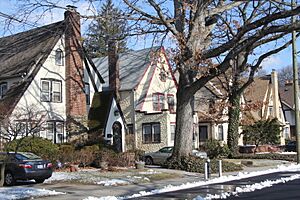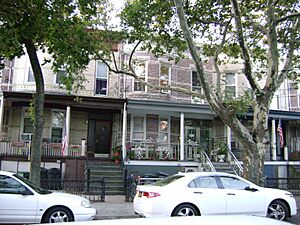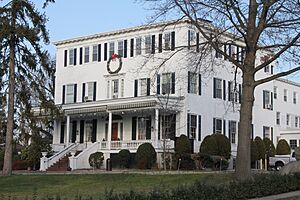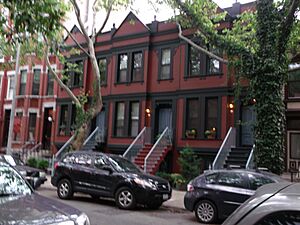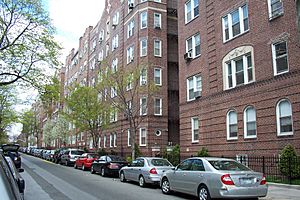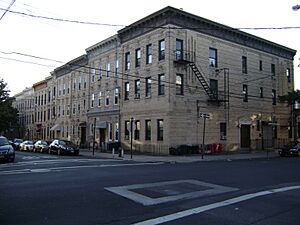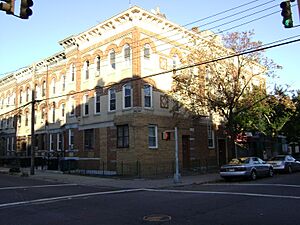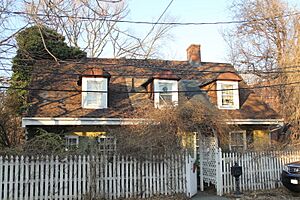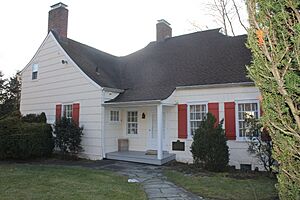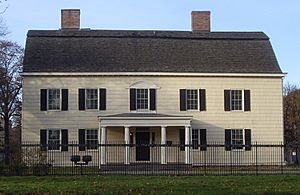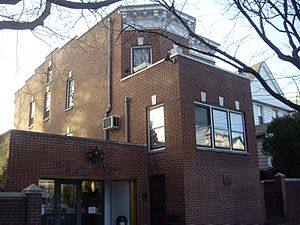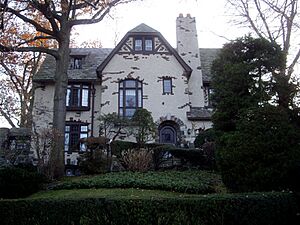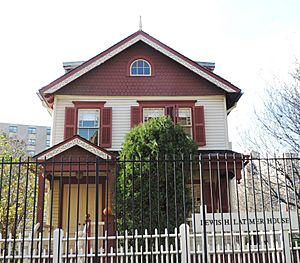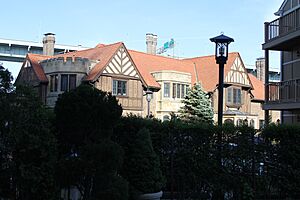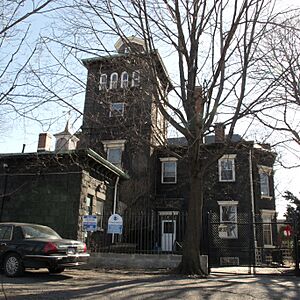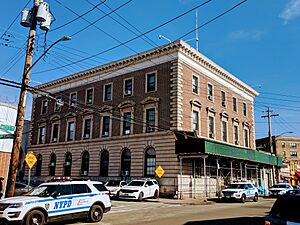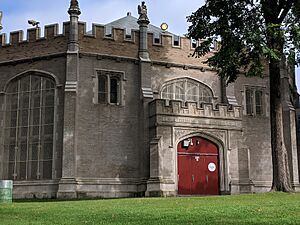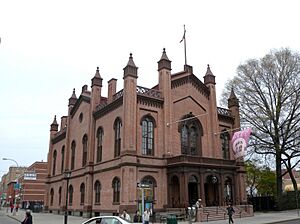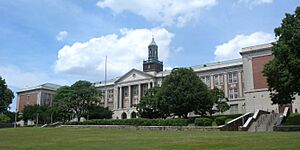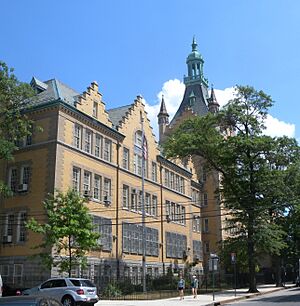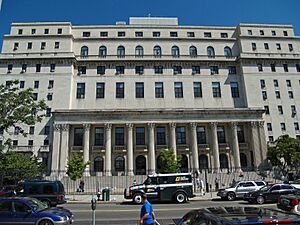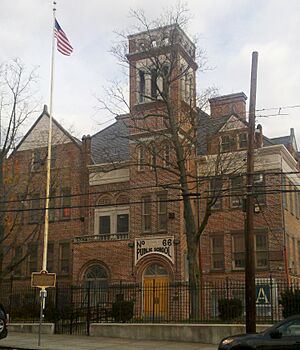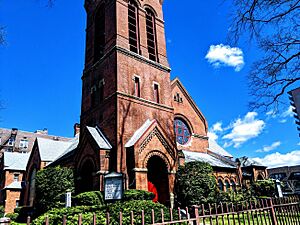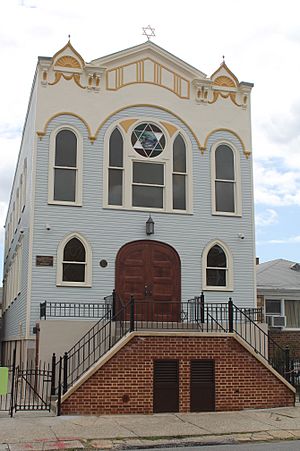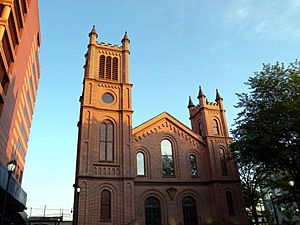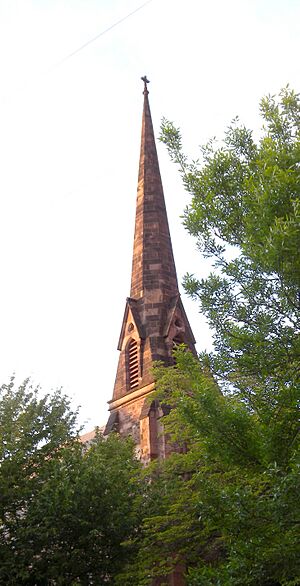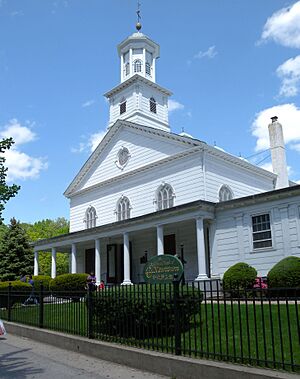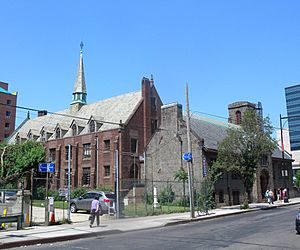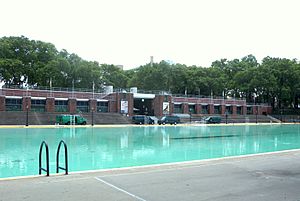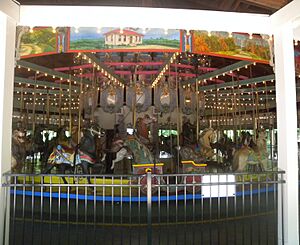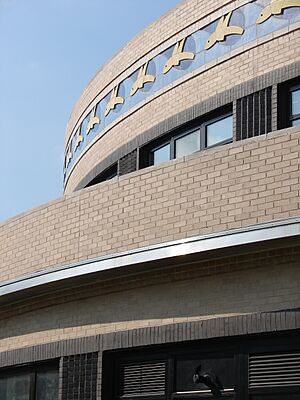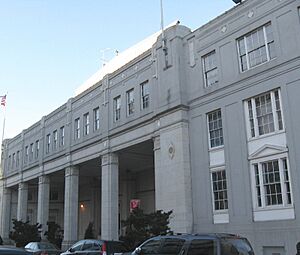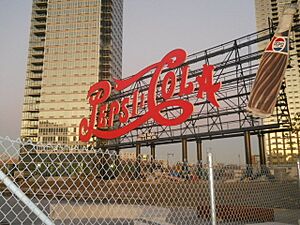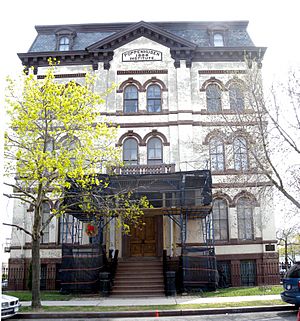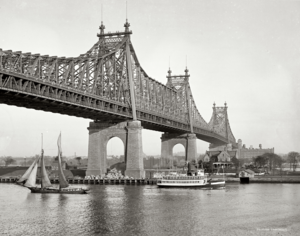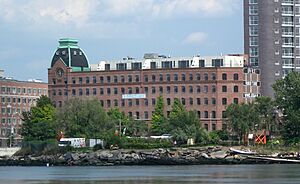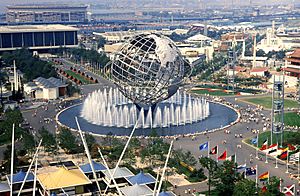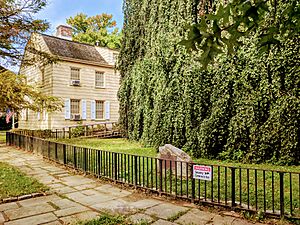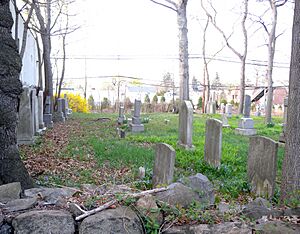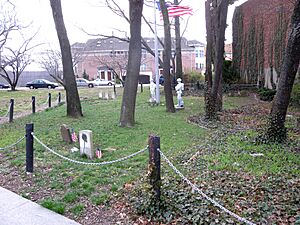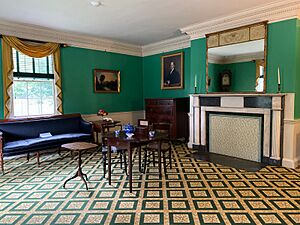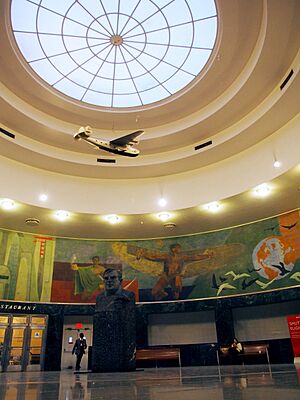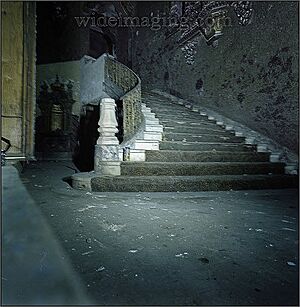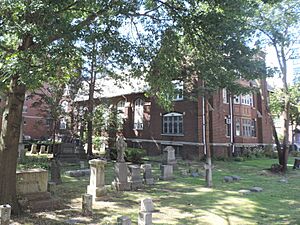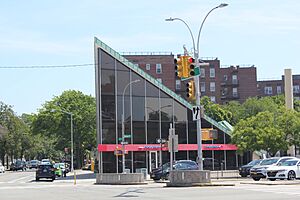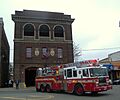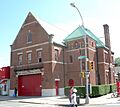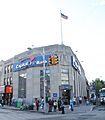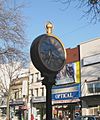List of New York City Designated Landmarks in Queens facts for kids
The New York City Landmarks Preservation Commission (LPC) was created in 1965. It's a special group in New York City that helps protect important buildings and places. They make sure these places are kept safe for everyone to enjoy for many years.
The LPC has named over a thousand landmarks! These landmarks are sorted into four types:
- Individual landmarks: These are single buildings or structures.
- Interior landmarks: These are special rooms or inside parts of buildings.
- Scenic landmarks: These are important parks or natural areas.
- Historic districts: These are whole neighborhoods with many old and important buildings.
The New York City borough of Queens has many of these special places. As of 2022, there are 82 individual landmarks, 4 interior landmarks, and 13 historic districts in Queens. Some of these are also called National Historic Landmark (NHL) sites, which means they are important to the whole country!
Contents
- Historic Districts in Queens: Protecting Special Neighborhoods
- Addisleigh Park Historic District: A Homey Neighborhood
- Cambria Heights Historic Districts: Storybook Homes
- Central Ridgewood Historic District: Brick Rowhouses
- Douglaston Historic Districts: Many Styles of Homes
- Fort Totten Historic District: A Former Military Base
- Hunters Point Historic District: Old Townhouses
- Jackson Heights Historic District: Planned Community Living
- Ridgewood North and South Historic Districts: Mathews Model Flats
- Stockholm Street Historic District: A Unique Brick Street
- Sunnyside Gardens Historic District: America's First Garden City
- Individual Landmarks in Queens: Special Buildings and Places
- Interior Landmarks in Queens: Hidden Treasures Inside
- Former Landmarks: Places That Lost Their Status
- Images for kids
Historic Districts in Queens: Protecting Special Neighborhoods
Historic districts are like time capsules! They are whole areas where many buildings have a special history or a unique look. Keeping them as historic districts helps save their original style and feel.
Addisleigh Park Historic District: A Homey Neighborhood
This district in St. Albans is full of single-family homes. They were built between the 1910s and 1930s in many different styles. It's also a U.S. historic district.
Cambria Heights Historic Districts: Storybook Homes
There are two historic districts in Cambria Heights: the 222nd Street and 227th Street districts. Both have many Storybook-style houses. These homes look like they came right out of a fairy tale! They were all finished in 1931.
Central Ridgewood Historic District: Brick Rowhouses
In Ridgewood, this district has many brick rowhouses. These homes were built between 1895 and 1927. Most are two stories tall with one apartment on each floor. It's also a U.S. historic district.
Douglaston Historic Districts: Many Styles of Homes
Douglaston has two historic districts: Douglaston Historic District and Douglaston Hill Historic District.
- The main Douglaston Historic District has over 600 single-family homes. They were built in different styles in the early and mid-20th century. It's also a U.S. historic district.
- Douglaston Hill Historic District has 31 single-family homes. These were built from the 1890s to the 1930s. It's also a U.S. historic district.
Fort Totten Historic District: A Former Military Base
This district in Fort Totten was once a military fort. It has over 100 buildings and structures. They were built from the 1830s to the 1960s.
Hunters Point Historic District: Old Townhouses
In Long Island City, this district has 47 townhouses. They were built between 1871 and 1890. They show off styles like Italianate and French Second Empire. It's also a U.S. historic district.
Jackson Heights Historic District: Planned Community Living
The Jackson Heights Historic District has many different residential buildings. They were built between 1914 and 1939. This area was planned as one of the largest communities of cooperative and garden apartments in the U.S. It's also a U.S. historic district.
Ridgewood North and South Historic Districts: Mathews Model Flats
These two districts in Ridgewood feature many three-story brick rowhouses. They are often called "Mathews Model Flats." They were built by the G.X. Mathews Company in the early 1900s.
Stockholm Street Historic District: A Unique Brick Street
This district in Ridgewood has 36 two-story brick rowhouses. They were built around 1907-1910. Stockholm Street is special because it's the only remaining brick street in Ridgewood!
Sunnyside Gardens Historic District: America's First Garden City
Located in Sunnyside Gardens, this district has 1,202 homes. It was developed between 1924 and 1928. It was the first garden city in the United States! It's also a U.S. historic district.
Individual Landmarks in Queens: Special Buildings and Places
Individual landmarks are single buildings, structures, or sites that are important on their own.
Historic Homes: From Colonial to Modern
Queens is home to many historic houses, showing different styles and eras.
- John Bowne House: This is the oldest house in Queens, built in 1661! It's an English Colonial house in Flushing. It was home to John Bowne and his family for nine generations. It's also on the National Register of Historic Places.
- Kingsland Homestead: The second oldest house in Flushing, this Dutch Colonial house was built in 1774. It's also on the National Register of Historic Places.
- Lent-Riker-Smith Homestead: This is New York City's oldest private house still used for its original purpose. Built in 1729, it's a Dutch Colonial farmhouse in Ditmars. It's also on the National Register of Historic Places.
- Vander Ende–Onderdonk House: In Ridgewood, this is one of the few 18th-century stone houses left in New York City. It has a unique gambrel roof. It's also on the National Register of Historic Places.
- Cornelius Van Wyck House: Another Dutch Colonial house, built in 1735 in Douglaston. It's one of the few remaining Dutch Colonial houses in New York City. It's also on the National Register of Historic Places.
- King Manor: This was the home of Rufus King, one of America's Founding Fathers. It's an 18th-century American Colonial house in Jamaica. It's a National Historic Landmark.
- Louis Armstrong House: The former home of famous musician Louis Armstrong in Corona. This brick house was built in 1910.
- Ralph Johnson Bunche House: The former home of diplomat Ralph Bunche in Kew Gardens. This neo-Tudor house was built in 1927. It's a National Historic Landmark.
- Lewis H. Latimer House: The former home of inventor Lewis H. Latimer in Flushing. This Queen Anne style house was built around 1887-1889.
- Arthur Hammerstein House: The former home of producer Arthur Hammerstein in Whitestone. This neo-Tudor house was built in 1924.
- Steinway Mansion: The home of piano maker William Steinway in Steinway. This Italianate villa was built around 1858. It's also on the National Register of Historic Places.
- Dizzy Gillespie Residence: This multi-family home in Corona was the residence of jazz legend Dizzy Gillespie for 12 years.
Important Public Buildings: Schools, Police Stations, and Courthouses
Many public buildings in Queens are also landmarks, showing different architectural styles.
- 53rd (now 101st) Precinct Police Station: The first police station built by the New York City government in the Rockaways. Located in Far Rockaway, it was built in 1927–1928.
- Flushing High School: New York City's oldest high school! Designed in the Collegiate Gothic style, it was built in Flushing between 1912 and 1915.
- Flushing Town Hall: This Romanesque Revival building in Flushing was built in 1862. It served as a courthouse and town hall. It's also on the National Register of Historic Places.
- Jamaica High School: Queens has two landmark buildings for Jamaica High School. The original building in Jamaica was built in 1895–1896 in the Dutch Revival style. The current building in Jamaica Estates was built in 1925–1927 in the Gothic Revival style.
- Newtown High School: This Flemish Renaissance Revival style high school in Elmhurst was built between 1917 and 1921. It has a cool turreted tower!
- Long Island City Courthouse: This English Renaissance Revival courthouse in Long Island City dates from 1872–1876. It was rebuilt in 1904–1908. It's also on the National Register of Historic Places.
- Queens General Court House: A Modern Classical courthouse in Jamaica, built between 1936 and 1939.
- Public School 48: An Art Deco school in South Jamaica, designed in 1932.
- Public School 66: This school in Richmond Hill was built in 1898. It shows off Victorian Eclectic, Romanesque Revival, and Queen Anne styles. It's also on the National Register of Historic Places.
Places of Worship: Churches and Synagogues
Several churches and a synagogue are recognized as landmarks.
- Protestant Reformed Dutch Church of Flushing (Bowne Street Community Church): A Romanesque Revival church in Flushing, built in 1891–1892. Flushing was an early center for religious tolerance.
- Congregation Tifereth Israel: A Gothic and Moorish synagogue in Corona, built in 1911. It's also on the National Register of Historic Places.
- First Reformed Church of Jamaica: A Romanesque Revival church in Jamaica, built in 1858–1859. It's also on the National Register of Historic Places.
- Grace Episcopal Church and Graveyard: A Gothic Revival church in Jamaica, built in 1861–1862. It has one of New York City's oldest graveyards. It's also on the National Register of Historic Places.
- Old Saint James Episcopal Church: A Colonial-era church in Elmhurst, dating from 1735–1736. It's also on the National Register of Historic Places.
- Reformed Dutch Church of Newtown and Fellowship Hall: One of New York City's few remaining churches made entirely of wood. Located in Elmhurst, it was built in 1831. It's also on the National Register of Historic Places.
- St. George's Church: A Gothic Revival church in Flushing, built in 1853–1854. It's a National Historic Landmark.
- St. Monica's Church: A Romanesque church in Jamaica, built in 1856. It has a cool central entrance tower. It's also on the National Register of Historic Places.
Other Interesting Landmarks: From Bridges to Carousels
- Astoria Park Pool and Play Center: One of several recreation centers built during the Works Progress Administration in 1936. It's in Astoria.
- Bank of Manhattan Company Building (Long Island City Clocktower): Queens' first skyscraper! This neo-Gothic clock tower in Long Island City was built in 1927.
- Forest Park Carousel: A beautiful carousel in Woodhaven with 52 figures. Most were carved by Daniel Muller from 1903 to 1909. It's also on the National Register of Historic Places.
- Marine Air Terminal: Located at La Guardia Airport in East Elmhurst, this Art Deco airport terminal was built in 1939–1940. It's the only active airport terminal from the early days of passenger air travel in the U.S. It's also on the National Register of Historic Places.
- New York Architectural Terra Cotta Works Building: This Renaissance and Tudor Revival building in Long Island City was built in 1892. It was the main office for New York Architectural Terra Cotta, the only company in the city that made architectural terracotta.
- Paramount Studios, Building No. 1 (Main Building): A concrete motion-picture studio in Astoria, built in 1920–1921. It's also on the National Register of Historic Places.
- Pepsi-Cola Sign: This electric sign in Long Island City used to advertise Pepsi-Cola's bottling factory. It's a famous landmark!
- Poppenhusen Institute: An Italianate and French Second Empire building in College Point. It served as a village hall, library, and even a jail! It's also on the National Register of Historic Places.
- Queensboro Bridge: This double-decked cantilever bridge connects Queens Plaza in Queens to Manhattan. Completed in 1909, it helped Queens grow a lot!
- Sohmer and Company Piano Factory: A German Romanesque Revival factory in Astoria for Sohmer & Co. pianos, built in 1886. It's also on the National Register of Historic Places.
- TWA Flight Center: This cool concrete and glass terminal at John F. Kennedy International Airport in Jamaica was built for Trans World Airlines between 1956 and 1962. It's also on the National Register of Historic Places.
- Unisphere and Reflecting Pool: A giant steel globe inside Flushing Meadows–Corona Park. It was built as a symbol for the 1964 New York World's Fair.
- Weeping Beech: A special Weeping beech tree planted by Samuel Parsons in 1847 in Flushing. The original tree was removed in 1999, but its legacy lives on.
Cemeteries: Glimpses into the Past
Several old cemeteries in Queens are landmarks, offering a look at early New York history.
- Brinckerhoff Cemetery: One of Queens' oldest colonial cemeteries, dating from 1730. It's in Fresh Meadows.
- Cornell Family Cemetery (Richard Cornell Graveyard): One of New York City's surviving 18th-century cemeteries. It was the private burial ground for the Cornell family in the 18th and 19th centuries in Far Rockaway.
- Lawrence Cemetery: This cemetery in Bayside has 40–50 graves for the Lawrence family, from 1832 to 1925.
- Lawrence Family Graveyard: Another cemetery for the Lawrence family, with 89 graves. It's in Steinway.
- Moore-Jackson Cemetery: One of New York City's few surviving Colonial-era cemeteries. It's in Woodside and has at least 51 burials from 1733 to 1868.
- Prospect Cemetery: The oldest graveyard in Jamaica, dating from 1665–1670. It's also on the National Register of Historic Places.
- Remsen Cemetery: A private cemetery in Rego Park dating from 1785–1795.
Interior Landmarks in Queens: Hidden Treasures Inside
Interior landmarks protect the special inside parts of buildings.
- King Manor (first floor interior): The first floor of King Manor (which is also an exterior landmark) has beautiful Georgian and Federal style features.
- Marine Air Terminal (main floor interior): The main floor of the Marine Air Terminal has a cool Modernist style. It features a large mural and a circular main room.
- RKO Keith's Flushing Theater (ground level interior): This Baroque theater in Flushing was built in 1927–1928. Its ground level interior is a landmark. It's also on the National Register of Historic Places.
- Trans World Airlines Flight Center (ground, main, and balcony level interior): The public spaces of the TWA Flight Center are also landmarks. This includes the main area with a balcony and two cool passageways called "flight tubes."
Former Landmarks: Places That Lost Their Status
Sometimes, a place is named a landmark but then loses that status. This can happen if the New York City Council votes against it, often due to opposition from the property owners.
- Grace Episcopal Memorial Hall: This hall was built in 1912 in the Tudor Gothic style. It was behind Grace Episcopal Church in Jamaica. It was delisted in 2011 because the New York City Council voted against its landmark status.
- Jamaica Savings Bank, Queens Boulevard: This Jamaica Savings Bank building in Elmhurst was built in 1966–1968. It was delisted in 2005 after the New York City Council voted against it.
- Loew's Triboro Theater: A Neo-Aztec theater in Astoria, built in 1930. It was delisted and demolished in 1974 after the New York City Board of Estimate voted against its landmark status.
- Sidewalk Clock, 36-34 Main Street: A classical cast-iron clock in Flushing, made around 1920. Its landmark status was removed in 1982, and the clock was taken away.
Images for kids


